Boosting Lumber Mill Profits with Moisture Measurement
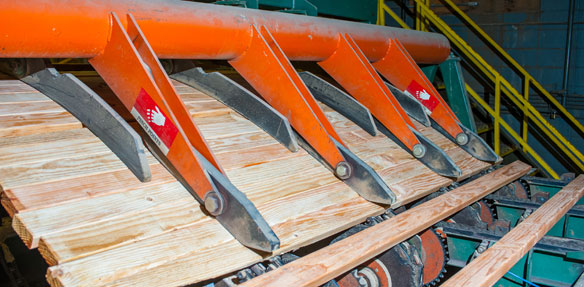
Written by Wagner Meters, published first by Canadian Forest Industries (Nov./Dec. 2014)
Hardwoods of Michigan, Inc., headquartered in Clinton, Michigan, has successfully developed and maintained a lumber quality control program that focuses on moisture content. As a result, it has improved its process efficiency, maximized output, and, most important of all, optimized profits.
Over the years, this 100-person operation has expanded its facilities to include a sawmill, a drying complex, and a planing/ripping line. Today, its kiln capacity is 700,000 board feet, pre-dryer capacity is 1.5 million board feet, and the monthly drying output is 1.5-1.8 million board feet. The mill processes hardwoods that include red and white oak, ash, hickory, maple, and cherry.
Drying Operations
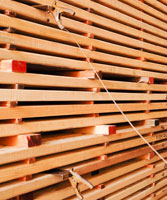 The drying complex at HMI Hardwoods includes seven kilns that, on average, can process up to 420,000 board feet at one time. Typically, it takes four hours to unload and reload a kiln. Aside from downtime to reload them, these kilns operate around the clock.
The drying complex at HMI Hardwoods includes seven kilns that, on average, can process up to 420,000 board feet at one time. Typically, it takes four hours to unload and reload a kiln. Aside from downtime to reload them, these kilns operate around the clock.
Unlike some mills, the team does not air-dry its lumber at any time because of higher inventory requirements and the lack of climate control outside. Variations and excesses in temperature, humidity, and wind velocity seasonally are factors that can cause lumber to degrade by 10% or more.
Moreover, air drying does not distribute evenly throughout the lumber. On the other hand, the normal pre-dryer degradation is 3 percent or less. This difference in yield savings (10% vs. 3%) improves the profitability of the mill.
One more reason for pre-drying instead of air-drying is that lumber can only be left outside for about six months out of the year in Michigan.
Pre-Kiln Operations
Stickers are affixed to newly-arrived green lumber, then that lumber is sorted by species and thickness and arranged into 80,000 board foot bays. Next, the bays are loaded into one of two pre-dryers that conduct temperature, humidity, and moisture checks throughout each 24/7 period.
- Stain-prone species such as maple are loaded into a specially-designed pre-dryer that has air velocities of 300-500 feet per minute and operating temperatures of 100-140° Fahrenheit, according to Randy Rickmon, HMI’s Pre-Drier Manager. Typically, the process requires 10-12 days to complete.
- Check-prone species such as oak are loaded into a second pre-dryer with air velocities of 100-125 feet per minute and operating temperatures of 80-90° Fahrenheit. Oak takes a longer time to process, typically 45-47 days.
Whitewoods are loaded into the pre-dryer for about 9 days, followed by 4 days in the kiln. Red oak takes much longer, going into the pre-dryer for about 36 days followed by 12 days in the kiln.
Quality Control in the Kiln
After the pre-drying process, HMI personnel moves the charges of lumber into the kiln. They do quality and moisture checks at this time, during which they prepare two types of samples that they assign randomly.
The first sample, usually about 16 boards, is chosen based on how they schedule and operate the kiln. These samples come from about 12,000 boards that make up the kiln charge.
They use the second set of samples after they finish the kiln process to evaluate degradation from moisture distribution and drying.
Moisture Meters: The Key to Quality Control after the Kiln
One hundred boards are randomly tagged from the 80,000 in the bay after they emerge from the kilns. These boards are then sent to HMI’s quality lab for further evaluation.
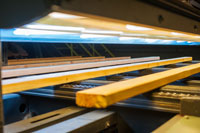 After they are surfaced, employees scan each board with a Wagner L601-3 handheld moisture meter. They record the moisture content of each board and inspect them for drying defects such as splitting, warping, checking, staining, and sticker marking.
After they are surfaced, employees scan each board with a Wagner L601-3 handheld moisture meter. They record the moisture content of each board and inspect them for drying defects such as splitting, warping, checking, staining, and sticker marking.
Each board is then rated on a scale of 0 to 4, with 4 being a perfect score for a board free of defects. They then prepare a report to summarize the moisture distribution and overall drying quality.
HMI surfaces most of its wood production. Unlike many mills, they plane or surface the lumber immediately following kiln-drying, and only then do they check the lumber’s moisture content. The order of when to test for moisture is reversed due to the mill’s layout.
After surfacing, each board passes over a Wagner in-line moisture detector. The ideal target for wood moisture is 7%, so any board that has a moisture content of 10% or higher is spray marked. These boards are then pulled out of the sorting line for reprocessing.
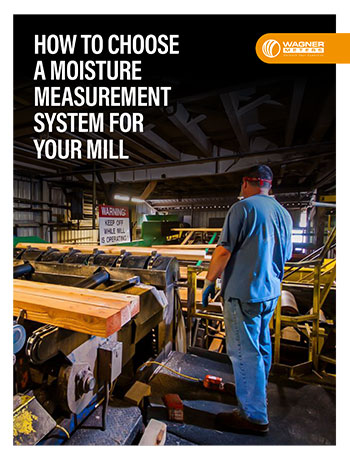
Free Download – How to Choose a Moisture Measurement System for Your Sawmill Buying Guide
Being able to screen out lumber with high moisture content has several benefits. It allows HMI to:
- assure customers of high-quality lumber and protect them from the many problems that can result from moisture content that is too high
- identify and more easily remove the occasional board that contains high levels of moisture, reducing the risk of extended kiln drying time that could over-dry the other wood in that charge
- maximize its wood production and, at the same time, save 10%-20% of costs compared to not scanning the wood for moisture content
The Role of Moisture Meters on Untagged Lumber
Untagged wood goes through Wagner’s in-line meter and scanner, which records each board.
Kiln size impacts wood moisture content. The bigger the kiln, the greater the variability of wood moisture content. Wagner’s in-line meter helps HMI catch boards that are too high or too low in moisture content.
If either is the case, employees pull the lumber from the line for reprocessing. The in-line meters outside the kiln help to minimize the risk of higher moisture content or over-drying.
Furthermore, Wagner’s meters help HMI save 10%-20% of costs. This maximizes yield and increases profits. Without the use of these meters, HMI would more likely produce lower-quality lumber with high moisture content and lose money in the process.
Bottom Line: Moisture Measurement Determines Profitability
Quality control can impact production yield and profitability. There are many components of a quality control program, but moisture content is one issue that, if addressed throughout the entire production process, can greatly impact your output as well as your profits.
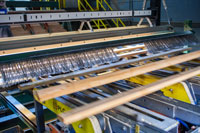 Developing and executing a quality control program that focuses on moisture measurement and analysis prior to, during, and after kiln drying can significantly improve your results.
Developing and executing a quality control program that focuses on moisture measurement and analysis prior to, during, and after kiln drying can significantly improve your results.
Using Wagner Meters’ in-kiln, inline and hand-held meters can help you determine the true moisture content of lumber. By using moisture content meters as part of its quality control program, HMI Hardwoods has seen a boost in its profits. What could better moisture measurement do for your mill?
Larry Loffer is a senior technician at Wagner Meters, where he has over 30 years of experience in wood moisture measurement. With a degree in Computer Systems, Larry is involved in both hardware and software development of wood moisture measurement solutions.
Last updated on June 7th, 2022



